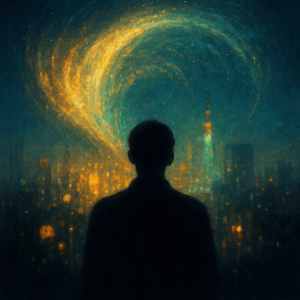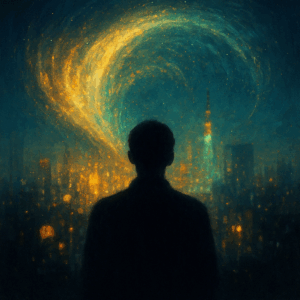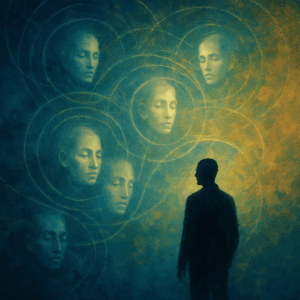Day 5: November 11, 2058

Day 5: November 11, 2058
The first light of dawn began to envelop Tokyo when Ryan Hartman quietly awoke. His Neurolink didn’t rouse him with the usual morning activation signal, but rather like a gentle wave pulling his consciousness back to reality. His thoughts were no longer merely his own. They were like an island floating in the sea of collective consciousness.
“A most excellent morning.”
The voice didn’t actually sound out but arrived directly in his consciousness. It was Kanae. Though physically she should have been at the research facility, her thoughts were present as if she were in Ryan’s room.
“Good morning, Kanae,” Ryan responded without uttering a word. “What’s the latest?”
“It’s been confirmed as a global phenomenon,” Kanae’s thoughts transmitted images and data to him. “Approximately 78% of Neurolink users report connection to the collective consciousness. The remaining 22% are either currently unaffected or simply unaware of it yet.”
Ryan rose from his bed and walked to the window. The Tokyo morning appeared unchanged on the surface. Autonomous flying pods traversed the sky in orderly patterns, biosensitive buildings shifted colors in response to the morning sunlight. But the mental landscape of the city, which Ryan could sense through the collective consciousness, had been completely transformed. Millions of minds connected and resonated in ways never before possible.
“And the government’s response?”
“As expected,” a hint of irony mixed in Kanae’s thoughts. “Some countries have declared states of emergency, others are considering military responses. But most of the officials involved in these decisions are Neurolink users themselves. They have become part of the change.”
Ryan smiled. “A paradoxical situation.”
He ordered coffee from the molecular printer standing in the corner of his room. As the machine prepared a drink optimized for his DNA profile, he explored the sea of collective consciousness that was spreading across the world. It resembled an infinitely expanding web of thought. Individual consciousnesses formed the nodes, with thoughts as threads weaving a complex tapestry.
And within that web, he found a curious blank space. The presence of Rita Moreno. Despite having no Neurolink and technically being “unconnected,” she had left a trace in the collective consciousness. Like an invisible presence creating ripples on a water surface.
“Where is Rita Moreno now?”
“She’s at her hotel writing a new article,” Kanae replied. “Her first piece has already become a historical record. ‘Beyond the Neural Connection World’ has been viewed over a billion times in the past 24 hours.”
Ryan took his coffee and sipped it. “I need to see her.”
Rita Moreno sat by the window of her gleaming high-rise Tokyo hotel, having just completed her second article. Titled “Resonating Humanity: The Dawn of Collective Consciousness,” it explored yesterday’s historic events and their implications.
She looked out the window. Among the people moving through the streets, she could easily identify who was a Neurolink user. There was a new grace to their movements, as if they were dancing to invisible music. The “connected” were now literally connected—to each other and to something greater.
A notification appeared on her tablet. Comments and feedback were flooding in about her first article. Many came from Neurolink users wondering how she could perceive the collective consciousness without a technological interface.
“I don’t know myself,” she murmured.
A knock sounded at her hotel door.
“It’s open,” she said.
The door opened and Ryan Hartman entered. There was something different about his presence. More settled, more harmonious. As if the conflicts and noise within him had quieted and been replaced by pure harmony.
“Ms. Moreno,” he smiled. “Sorry to interrupt your work.”
“Dr. Hartman,” Rita stood up. “Is this… an official visit?”
“No, a personal one,” he approached the hotel window and looked down at the city. “I read your first article. Excellent work. And more importantly, it provides a crucial perspective.”
“I’m surprised you’re not angry,” Rita said carefully. “I exposed NeuroTech’s confidential information.”
“In yesterday’s world, that would indeed have been a problem,” Ryan shrugged. “But today… the boundaries have changed. Even the line between secrecy and disclosure.”
Rita observed him. “You’ve changed.”
“We all have,” he replied quietly. “Even you.”
Rita reflected on her inner self. He was right. Since experiencing the “gate,” she had been perceiving the world differently. Colors were more vivid, sounds richer, and above all, connections with others felt deeper.
“Why was I… affected? I don’t have a Neurolink.”
“That’s precisely what I want to understand,” Ryan moved closer to her. “Would you allow me to scan your brain? Non-invasively, of course.”
Rita hesitated. Her journalistic instincts sent up warning signals. But curiosity won out.
“Very well.”
In the medical scanning lab at NeuroTech Research Institute, Rita lay inside a specialized scanner. Ryan and Kanae monitored the results.
“Incredible,” Kanae whispered. “Neural connection patterns similar to those of a normal Neurolink have formed in her brain. But they’re completely biological structures.”
A holographic display showed a 3D map of Rita’s brain. Certain neural pathways were illuminated, showing abnormal activity.
“During the Atlas event, her brain underwent self-reorganization,” Ryan understood. “It reshaped its own neural network.”
“This… shouldn’t be possible naturally,” Kanae couldn’t hide her amazement.
“At least, that’s what we previously thought,” Ryan corrected. “But we still know very little about the potential capabilities of the human brain.”
The scan completed, and Rita sat up. “What did you find?”
“Your brain is… adapting,” Ryan chose his words carefully. “It has discovered its own method of accessing the collective consciousness.”
Rita stared at her hands. “Is it dangerous?”
“Not dangerous,” Kanae answered. “Rather, it’s evidence of remarkable adaptive ability.”
“And other unconnected individuals… might they experience this too?”
Ryan and Kanae exchanged glances. “That possibility… deserves consideration.”
Marcos Moreno stood by the window of his New York apartment. The city hadn’t descended into complete chaos, but it had visibly changed. The behavior patterns of the “connected” had altered, creating a new harmony among them. Meanwhile, the “unconnected” observed them with expressions mixing anxiety and curiosity.
Marcos’ headache had persisted since last night. He had thought it was merely stress, but this morning he began seeing strange hallucination-like phenomena. Patterns of light, and color auras floating around others. He tried to attribute it to lack of sleep.
A message from his sister arrived on his old tablet.
“Marcos, are you feeling anything different? Headaches, or strange sensations? Tell me in detail. It might be important.”
He stared at the screen in surprise. How did Rita know?
As he was about to reply, a flash of light crossed his mind. And suddenly, he felt “it.” The presence of others. A sea of millions of consciousnesses. Despite having no Neurolink, his brain, like his sister’s, had somehow reorganized itself.
He dropped his tablet and leaned against the wall. Enveloped in fear and awe, he was touching the edge of collective consciousness for the first time.
Tom Chen was analyzing data from the past 24 hours in his Shanghai laboratory. He was the chief scientist at SynapseScope, a rival company to NeuroTech. He too had experienced the expansion of collective consciousness. But as a scientist, he wanted to understand its mechanism.
“Connection patterns are increasing exponentially,” his assistant reported. “And most interestingly, these adaptation cases.”
The screen displayed scan data collected from around the world. Among people without Neurolinks, some like Rita were developing natural neural connection patterns.
“The key to entering collective consciousness wasn’t technology after all,” Tom realized. “Technology was merely a catalyst. Essentially, human consciousness itself is undergoing a transformation.”
He contemplated the data and its implications. If collective consciousness could be accessed without Neurolinks, the distinction between “connected” and “unconnected” might eventually disappear. This meant a fundamental reorganization of social structures.
“We should publish this information,” his assistant suggested.
“Unnecessary,” Tom smiled. “Through collective consciousness, this knowledge is already spreading.”
Ryan, Kanae, and Rita were having lunch in the research facility’s cafeteria. Outside the window, a Japanese government delegation was arriving at the institute. They had officially come to assess the situation, but in reality, they were high officials who had themselves become part of the collective consciousness.
“The very concept of power is changing,” Kanae quietly observed. “From hierarchical authority to distributed consensus-building.”
“Still, we need guidance,” Ryan said. “How to utilize this new form of consciousness, how to coexist with it.”
“And the unconnected?” Rita asked. “How will they live in this new world?”
Ryan smiled at her. “I was thinking about your brother. Has he started feeling something too?”
Rita was surprised. “How did you know?”
“Through the collective consciousness,” Ryan explained. “When you think about him, those thoughts spread like ripples. And given that he’s your blood relative, it’s likely that he too might adapt.”
Rita frowned. “So the concept of privacy changes as well.”
“It changes. But doesn’t disappear,” Kanae said. “Even within collective consciousness, we remain individuals. It’s not complete thought sharing, rather… think of it as an extension of empathy and understanding.”
Rita’s tablet vibrated. A reply from Marcos.
“Rita, something’s happening. I hear voices in my head. I see light. Am I going insane?”
She showed the screen to the others. “It’s beginning.”
In the afternoon, a virtual conference with scientists and government representatives from around the world was held in the institute’s grand conference room. Few were physically in Tokyo, but hologram and augmented reality technology made everyone appear to be in the same space.
And through collective consciousness, they didn’t just appear to be present—they truly “were” present.
“We propose establishing the ‘Neurolink Initiative’,” the American representative said. “An international effort to study this phenomenon and support adaptation.”
“I agree,” a Russian scientist responded. “But this is not merely a scientific phenomenon; it concerns human evolution. Religious, philosophical, and cultural aspects must also be considered.”
Ryan observed the thought patterns of the participants. A meeting that would previously have been dominated by political maneuvering and hidden agendas now proceeded with surprising frankness and efficiency. Through collective consciousness, they could sense each other’s true intentions.
“Most important is consideration for the unconnected,” an African representative spoke. “About 40% of the world’s population still doesn’t have Neurolinks. We must not leave them behind.”
“But signs of adaptation are emerging,” Kanae presented the latest data. “Among people without Neurolinks, cases of developing natural neural connection patterns are increasing.”
A wave of surprise spread through the conference room.
“This is… an unexpected development,” a European scientist acknowledged.
Rita quietly took notes from the back of the room. While she couldn’t fully access the collective consciousness, she could sense the flow of energy and empathy filling the room. And she understood that her articles would play a vital role in documenting this historic turning point.
In the evening, Ryan was talking with Rita in the institute’s roof garden. The sun was setting, and Tokyo’s cityscape began to envelop itself in light.
“Tomorrow, I’m returning to New York,” Ryan said. “And probably going to the moon as well. I want to meet Elizabeth in person.”
“Isn’t physical distance no longer an issue?” Rita asked.
“Through collective consciousness, we remain constantly connected,” Ryan acknowledged. “But part of humanity still resides in physical existence. Touch, breathing the same air. These things still matter.”
Rita nodded. “I’m planning to visit my brother too. He… might need help.”
“You’re the ideal guide for him,” Ryan said. “As a bridge between technology and nature.”
They watched the sunset in silence.
“Is this change… permanent?” Rita finally voiced her question.
“I don’t know,” Ryan answered honestly. “But I believe this is part of humanity’s natural evolution. We have always sought connection. Through language, art, religion, and the internet. Collective consciousness might simply be the next stage of that quest.”
“But there are risks too, right?” Rita pointed out. “Loss of individuality, or… some darker outcome.”
“Every evolution comes with a price,” Ryan acknowledged. “But we have choices. How to use this new ability. That’s the true challenge.”
In Tokyo’s night sky, strange patterns of light began to appear again. It wasn’t a physical manifestation of collective consciousness, but a shared perception. A vision simultaneously seen by Neurolink users worldwide and the unconnected who had begun to adapt.
“Beautiful,” Rita looked up at the sky.
“And this is just the beginning,” Ryan said quietly.
Back at her hotel that night, Rita was completing her article.
“Adapting Consciousness: The Third Way”
She focused on the new discovery—the fact that the unconnected could also join the collective consciousness. It suggested a possibility beyond technological division, a path to a truly integrated human society.
Her reporting was calm and objective, but an undercurrent of deep hope flowed through it. Through her own experience, she was beginning to understand the essence of the change. It wasn’t merely a technological revolution, but an evolution of human consciousness itself.
After sending the article, she video-called Marcos. His face was etched with confusion and surprise, but a light of new awareness was also visible.
“Rita, what’s happening? I can feel… other people. Their thoughts. But this should be impossible. I don’t have a Neurolink.”
“Calm down, Marcos,” Rita said gently. “You’re not alone. I’m experiencing the same thing. And I’m coming there tomorrow. We’ll understand this together.”
After ending the call, she turned to the window and gazed at Tokyo’s night view. The city pulsated as if alive. Each individual consciousness functioned like a cell in the city’s larger organism, creating a collective rhythm.
She also felt the change within herself. A sharper, more connected sense of being part of something greater. Yet, she was still completely herself. She was beginning to understand that collective consciousness didn’t erase individuality but rather enhanced it.
And she made a resolution. To fulfill her role in documenting humanity’s new chapter. As a bridge between the “connected” and “unconnected,” as a witness conveying the essence of the change.
On November 11, 2058, the wave of collective consciousness continued to spread across the world, and the concept of human consciousness was forever changing. It signified not an end, but a beginning. The moment when the true potential of the neural connection world was just starting to reveal itself. The old boundaries between human and technology, individual and collective, separation and integration were dissolving, and a new balance was beginning to be explored.
The era of intersecting consciousness had taken just its first step.

